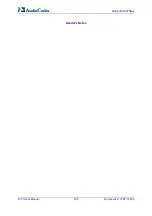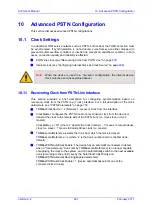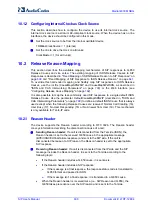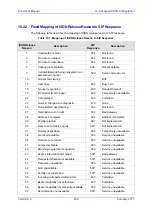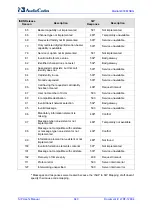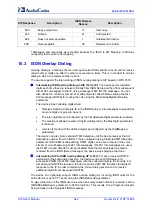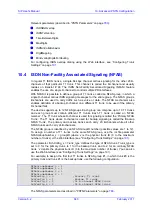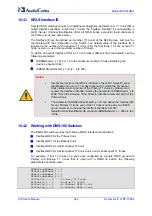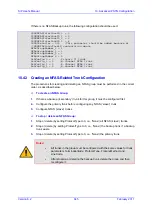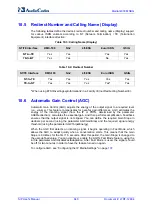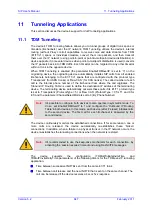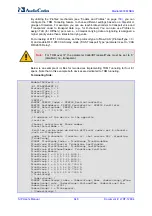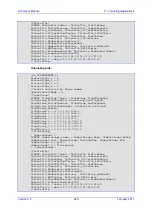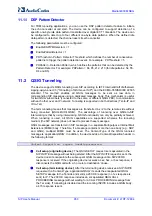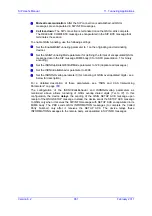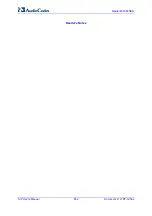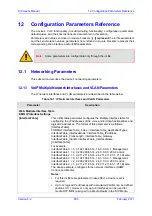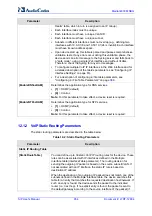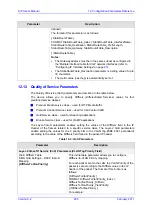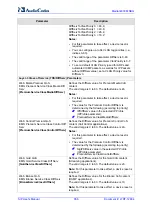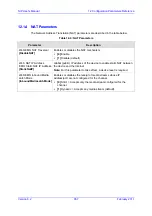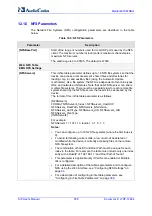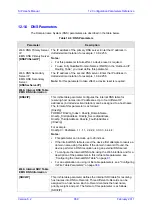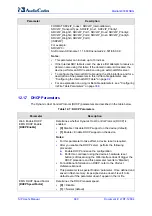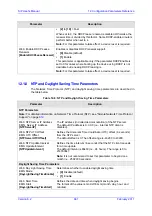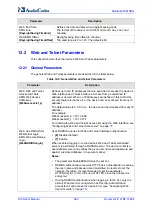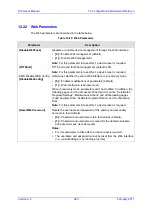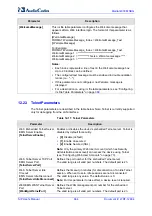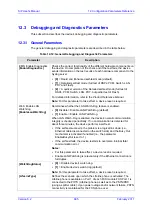
SIP User's Manual
650
Document #: LTRT-12804
Mediant 800 MSBG
11.1.1 DSP Pattern Detector
For TDM tunneling applications, you can use the DSP pattern detector feature to initiate
the echo canceller at call start. The device can be configured to support detection of a
specific one-byte idle data pattern transmitted over digital E1/T1 timeslots. The device can
be configured to detect up to four different one-byte data patterns. When the defined idle
data pattern is detected, the channel resets its echo canceller.
The following parameters must be configured:
EnableDSPIPMDetectors = 1
EnablePatternDetector = 1
PDThreshold - Pattern Detector Threshold, which defines the number of consecutive
patterns to trigger the pattern detection event. For example: PDThreshold = 5
PDPattern - Detection Pattern, which defines the patterns that can be detected by the
Pattern Detector. For example: PDPattern = 84, 85, 212, 213 (for idle patterns: 54, 55,
D4 and D5)
11.2 QSIG Tunneling
The device supports QSIG tunneling over SIP according to IETF Internet-Draft draft-elwell-
sipping-qsig-tunnel-03 ("Tunnelling of QSIG over SIP") and the ECMA-355/ISO/IEC 22535
standard. This method enables all QSIG messages to be sent as raw data in
corresponding SIP messages using a dedicated message body. This mechanism is useful
for two QSIG subscribers (connected to the same or different QSIG PBX) to communicate
with each other over an IP network. Tunneling is supported in both directions (Tel-to-IP and
IP-to-Tel).
The term tunneling means that messages are transferred ‘as is’ to the remote side without
being converted (QSIG
Æ
SIP
Æ
QSIG). The advantage of tunneling over QSIG-to-SIP
interworking is that by using interworking, QSIG functionality can only be partially achieved.
When tunneling is used, all QSIG capabilities are supported, whereas the tunneling
medium (the SIP network) does not need to process these messages.
QSIG messages are transferred in SIP messages in a separate Multipurpose Internet Mail
Extensions (MIME) body. Therefore, if a message contains more than one body (e.g., SDP
and QSIG), multipart MIME must be used. The Content-Type of the QSIG tunneled
message is ‘application/QSIG’. In addition, the device adds a Content-Disposition header in
the following format:
Content-Disposition: signal; handling=required.
Call setup (originating device):
The QSIG SETUP request is encapsulated in the
SIP INVITE message without being altered. After the SIP INVITE request is sent, the
device doesn’t encapsulate the subsequent QSIG message until a SIP 200 OK
response is received. If the originating device receives a 4xx, 5xx, or 6xx response, it
disconnects the QSIG call with a ‘no route to destination’ cause.
Call setup (terminating device):
After the terminating device receives a SIP INVITE
request with a 'Content-Type: application/QSIG', it sends the encapsulated QSIG
SETUP message to the Tel side and sends a 200 OK response (no 1xx response is
sent) to IP. The 200 OK response includes an encapsulated QSIG CALL
PROCEEDING message (without waiting for a CALL PROCEEDING message from
the Tel side). If tunneling is disabled and the incoming INVITE includes a QSIG body,
a 415 response is sent.
Содержание Mediant 800 MSBG
Страница 2: ......
Страница 366: ...SIP User s Manual 366 Document LTRT 12804 Mediant 800 MSBG Reader s Notes ...
Страница 372: ...SIP User s Manual 372 Document LTRT 12804 Mediant 800 MSBG Reader s Notes ...
Страница 390: ...SIP User s Manual 390 Document LTRT 12804 Mediant 800 MSBG Reader s Notes ...
Страница 404: ...SIP User s Manual 404 Document LTRT 12804 Mediant 800 MSBG Reader s Notes ...
Страница 616: ...SIP User s Manual 616 Document LTRT 12804 Mediant 800 MSBG Reader s Notes ...
Страница 636: ...SIP User s Manual 636 Document LTRT 12804 Mediant 800 MSBG Reader s Notes ...
Страница 652: ...SIP User s Manual 652 Document LTRT 12804 Mediant 800 MSBG Reader s Notes ...
Страница 886: ...SIP User s Manual 886 Document LTRT 12804 Mediant 800 MSBG Reader s Notes ...
Страница 890: ...User s Manual Ver 6 2 www audiocodes com ...

